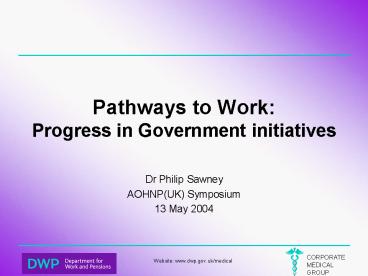Pathways to Work: Progress in Government initiatives PowerPoint PPT Presentation
1 / 24
Title: Pathways to Work: Progress in Government initiatives
1
Pathways to WorkProgress in Government
initiatives
- Dr Philip Sawney
- AOHNP(UK) Symposium
- 13 May 2004
2
Department for Work and Pensions
- Created 2001 from former DSS and part DfEE
- Corporate centre and agencies
- Jobcentre Plus
- Pensions Service
- Disability and Carers Service
- Child Support Agency
- The Appeals Service
- Spends 115 billion /year 3 bn running costs
- 120,000 staff
- Sponsoring Dept for HSC/ HSE
3
DWP
- Promote opportunity and independence for all
- 10 Public Service Agreement targets
- Working with others
- Health Depts England,Scotland,Wales
- Inland Revenue
- DfES
- Local authorities
- Employers
- Voluntary sector
- Commercial partners
4
People of working age
- Objective to promote work as the best form of
welfare whilst protecting the position of those
in greatest need - Delivery Targets (PSA)
- Increase overall employment rate over economic
cycle - Increase the employment rate of people with
disabilities, taking account of the economic
cycle, and significantly reduce the difference
between their employment rate and the overall
rate. - Work to improve the rights of disabled people and
to remove barriers to their participation in
society
5
Jobcentre Plus
- Helps people to find/access work and receive
benefits - Helps employers fill their vacancies
- Front office services for others eg DCS
- Implements labour market policies
- New initiatives
- Employment Zones
- New Deals
- Worklessness pilots
- Pathways to Work
6
Disability Employment Strategy
- Focus on what people can still do - with support
to work - Systems support/encourage activity rather than
inactivity - Interventions at earlier stage
- Agencies working together
- Healthcare systems treat work outcomes as a key
element of clinical management - Employer engagement
- Further develop the evidence base for
rehabilitation
7
Why do we need this strategy ?
- 2.7 million people of working age on a state
incapacity benefit lt 1 million unemployed - 1 million report sick each week 3000 remain off
work at 6 months and 80 of these will not work
again in next 5 years - 20 of people of working age have a long term
disability - 50 of the disabled population in the UK are
economically inactive (versus 15 of the
non-disabled)
8
IB Growth 1979 - 2001
9
IB claim trends
10
IB some diagnoses predominate
11
Pathways to Work Nov 02/June 03
12
The case for reform
- Health
- Social
- Economic
13
Return to work should be a positive realistic
option
- Satisfying Personal Capability Assessment (PCA)
does not necessarily mean incapable of any sort
of work - Almost everyone moving onto Incapacity Benefit
says they want to work again - Most have more manageable conditions where
outlook should be positive - For most people return to full activity (incl.
work) will improve health and well-being
14
Effects of worklessness
- Acheson (1998)
- worklessness as a major risk to health
- For the majority being away from work has a
significant adverse effect on health through - isolation, social exclusion and stigma
- changing health related behaviour
- disruption to future career
- lower income than available through work
15
Obstacles to rehabilitation
- Lack of intervention and support
- Skills and qualifications
- Medical issues
- Financial support
- Employers role
- Communication problems
- Managing uncertainty
- Stigma and discrimination
- steps to activation are undermined
16
Obstacles to rehabilitation
- Not just Government saying this..
- Vocational Rehabilitation The Way Forward -
BSRM, 2nd Ed Dec 2003 - Second UK Bodily Injury Awards Study - Oct 2000
- CBI report Business and healthcare for 21st
century - Dec 2001 - ABI/TUC paper Getting back to work June 2002
- Employment Opportunities and Psychiatric
Disability RCPsych 2003
17
Helping people realise aspirations - creating
better pathways to work
- Key principles
- Early skilled intervention -gt best chance for
help - Better specialist support, esp. health-work
aspects - Making sure work clearly pays
- Better support for people on JSA with health
problems - Jobcentre Plus working in partnership- NHS and
employers also key
18
Pathways to Work the bio-psychosocial model
of rehabilitation
- Limitations of traditional health care
- Models of disability
- Modern concepts of vocational rehabilitation
- Addressing the real obstacles
- Developing the evidence base
19
Bio-psychosocial model and Pathways pilots
AXIS ELEMENT PATHWAYS FEATURE
Bio Impairment Function Legal framework Residual functional capacity
Psycho- Attitudes beliefs Psychological distress Coping strategies Illness behaviour Earlier intervention Integrated support Condition management progs Clearer messages
Social Occupational demands/adjustments Economic incentives Cultural attitudes Employer strategy Return to work credit Involving other stakeholders
20
Other stakeholders
- DWP/Jobcentre Plus cannot provide the whole
solution - Other stakeholders to focus on agenda that
encourages those with health problems/disabilities
to remain in, or return to, work
21
Pathways pilots update
- Public consultation Govt response June 2003
- working with key stakeholders especially NHS
(Condition Management Programmes) - 7 pilot areas
- Oct 03 - Bridgend Renfrewshire Derbyshire
- April 04 -Somerset Essex E.Lancs Gateshead
- Full evaluation 2003 - 2006
22
Other DWP/Government initiatives
- Jobcentre Plus
- Anti-discrimination / focus on abilities
- New Deal for Disabled People
- Benefit rule changes permitted work
- Job Retention and Rehabilitation Pilots (RCT)
- Health Inequalities / Social Exclusion Unit
- Securing Health Together
- ELCI and Framework for Vocational Rehabilitation
23
Culture - a new understanding
- Recognise diversity and individual need
- Disability and work a mainstream issue
- Dynamic nature of conditions
- Need to consider functional capacity
- Recognise influence of psychological and social
factors
24
More information
- www.dwp.gov.uk/medical

